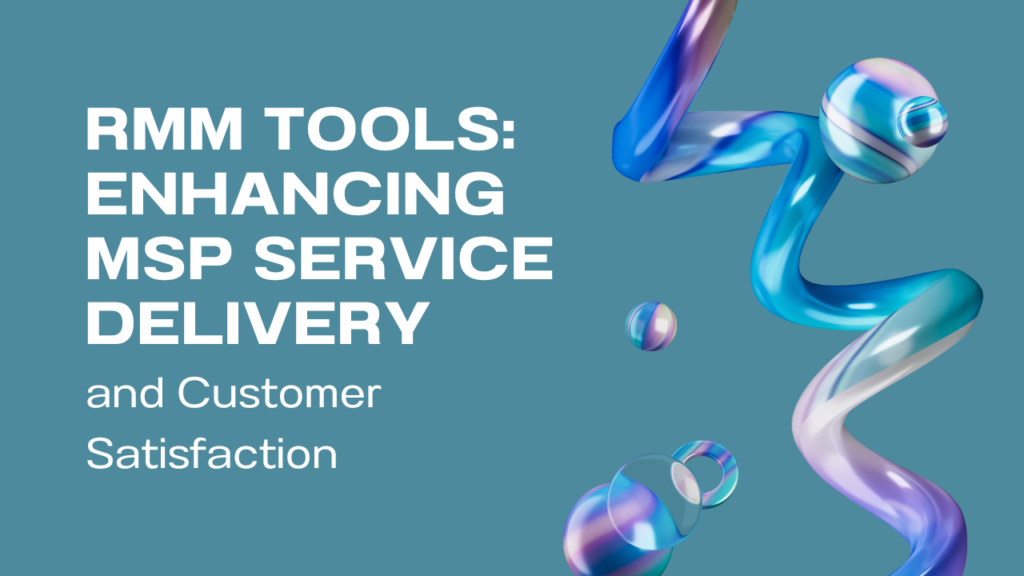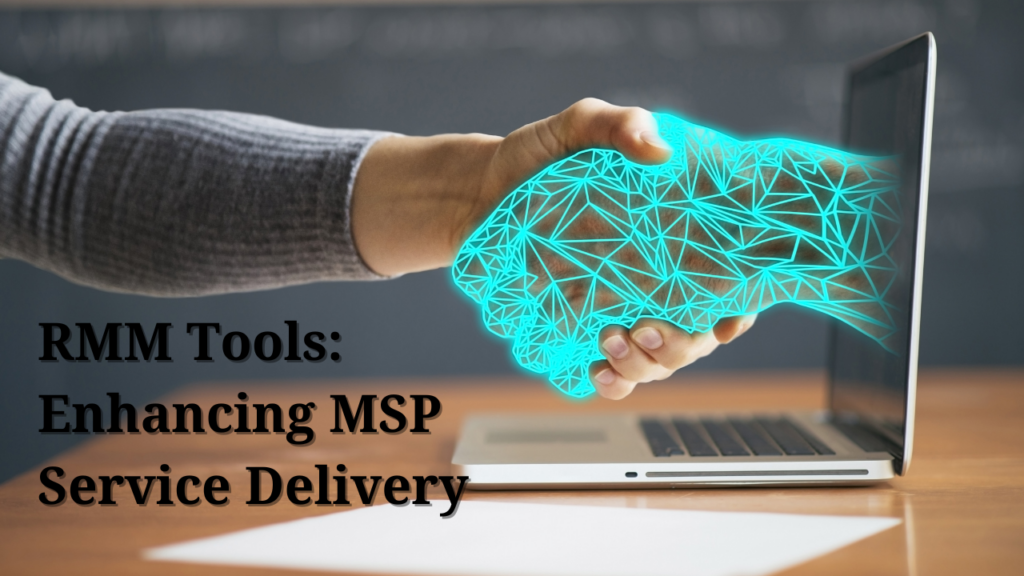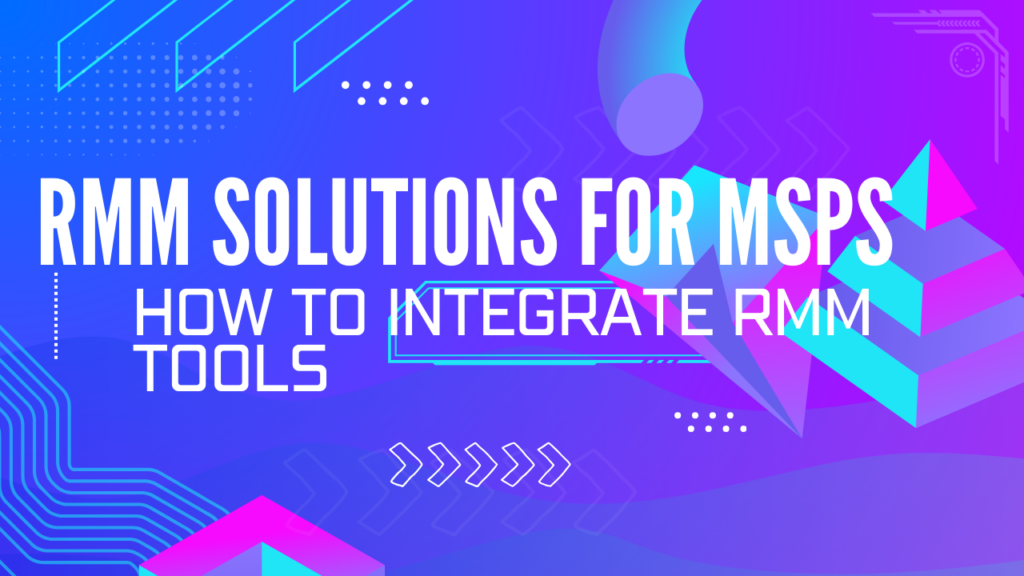Remote Monitoring and Management (RMM) tools are pivotal for MSPs aiming to optimize service delivery and enhance client satisfaction. By providing real-time alerts, automated maintenance, and efficient patch management, RMM tools help MSPs proactively address issues, reducing downtime and ensuring a secure IT environment. This article delves into how integrating RMM tools can significantly improve operational efficiency and client trust, thereby fostering business growth.

Introduction
- Explanation of Remote Monitoring and Management (RMM) tools and their relevance to MSPs.
- Overview of how MSP RMM tools enhance service delivery and boost client satisfaction.
Remote Monitoring and Management (RMM) tools are indispensable for Managed Service Providers (MSPs) aiming to optimize their service delivery and boost client satisfaction. These tools provide MSPs with the ability to monitor client systems remotely, manage IT infrastructure proactively, and automate routine tasks. By integrating RMM tools, MSPs can deliver more efficient and effective services, reducing downtime and enhancing security. According to a study by Infraon, MSPs leveraging RMM tools can identify system issues before they escalate, ensuring continuous operational efficiency and client trust.
The relevance of RMM tools to MSPs cannot be overstated. They offer real-time alerts, automated maintenance, and efficient patch management, which are crucial for maintaining a secure and functional IT environment. For instance, Simeon Cloud highlights that MSPs using automation through MSP RMM tools can significantly improve efficiency and customer satisfaction by streamlining their operations and reducing manual workload. This article delves into how RMM tools can significantly improve MSP operations, enhance client satisfaction, and drive business growth.
Key Features of MSP RMM Tools
Automated Monitoring and Alerts
- How RMM tools proactively monitor client systems for issues.
- Benefits of real-time alerts to prevent downtime.
Remote Support Capabilities
- Tools and technologies that enable remote troubleshooting and maintenance.
- Advantages of remote support for quick resolution of client issues.
Patch Management
- Automated patching processes to ensure system security and up-to-dateness).
- Impact of patch management on reducing vulnerabilities.
Automated Monitoring and Alerts
RMM tools excel in providing automated monitoring and real-time alerts, which are critical for proactive issue resolution. These tools continuously monitor client systems for any signs of trouble, such as performance degradation, unusual activity, or potential security threats. When an issue is detected, the RMM tool immediately sends an alert to the MSP, allowing for quick intervention before the problem escalates.
For example, the Infraon blog explains that real-time alerts help MSPs to prevent downtime by addressing issues as soon as they arise. This proactive approach not only ensures that client systems remain operational but also builds trust as clients see their MSP actively managing and protecting their IT infrastructure.
Remote Support Capabilities
One of the most valuable features of RMM tools is their ability to provide remote support. This capability allows MSPs to troubleshoot and resolve client issues without the need for an on-site visit, which can be time-consuming and costly. Remote support tools include functionalities such as remote desktop access, file transfer, and remote command execution, which streamline the process of diagnosing and fixing problems.
The ability to offer remote support leads to quicker resolution times and minimizes downtime for clients. According to a blog post by Intertec International, remote support through MSP RMM tools is essential for MSPs to deliver efficient and responsive service. This feature not only enhances client satisfaction but also allows MSPs to manage a larger number of clients more effectively.
Patch Management
Automated patch management is a crucial feature of RMM tools that ensures client systems are always up-to-date with the latest security patches and software updates. This process helps in mitigating security vulnerabilities and maintaining the overall health of IT systems. By automating patch management, RMM tools reduce the risk of human error and ensure that patches are applied promptly across all client devices.
WatchGuard’s blog emphasizes the importance of automated patch management in maintaining a secure IT environment for clients. MSPs that utilize RMM tools for patch management can assure their clients that their systems are protected against known vulnerabilities, thereby enhancing trust and satisfaction.
Benefits of RMM Tools for MSPs
Increased Operational Efficiency
- How automation in RMM tools reduces the need for manual tasks.
- Case studies demonstrating efficiency gains from RMM deployment.
Enhanced Client Security
- Role of RMM tools in identifying and mitigating security threats.
- Importance of security in maintaining client trust and satisfaction.
Scalability
- How RMM tools facilitate the scaling of MSP services to handle more clients or more complex networks.
- Examples of scalable MSP RMM solutions in action.
Increased Operational Efficiency
Automation provided by RMM tools significantly reduces the need for manual intervention in routine tasks. This efficiency gain allows MSPs to allocate resources to more strategic activities, ultimately enhancing service delivery. For example, an MSP deploying an RMM tool saw a 30% reduction in manual workload, enabling the team to focus on critical client projects, say Simeon Cloud.
Enhanced Client Security
Security is a top concern for MSPs and their clients. RMM tools play a pivotal role in identifying and mitigating security threats. By continuously monitoring for unusual activities and deploying security patches promptly, MSPs can protect client systems from breaches. This proactive approach not only secures client data but also strengthens client trust and satisfaction – as explained by WatchGuard.
Scalability
RMM tools enable MSPs to scale their services efficiently, accommodating more clients or managing more complex networks. Scalable RMM solutions allow for seamless integration of new devices and systems, ensuring consistent service quality as the MSP grows. Case studies have shown that MSPs leveraging scalable RMM tools can expand their client base by up to 40% without compromising on service quality (Infraon).
Choosing the Right RMM Tool
Evaluation Criteria for Selecting an MSP RMM Tool
- Essential features and functionalities to look for.
- Compatibility with existing MSP services and infrastructure.
Comparison of Popular RMM Tools
- Overview of leading RMM solutions in the market.
- Key differences and unique selling points.

Evaluation Criteria for Selecting an RMM Tool
When selecting an RMM tool, MSPs should consider essential features such as automated monitoring, remote support capabilities, and robust patch management. Compatibility with existing MSP services and infrastructure is also crucial. An effective RMM tool should integrate seamlessly with other tools and platforms used by the MSP, ensuring smooth operations and minimal disruption (Atera).
Selecting the right RMM tool is crucial for MSPs to ensure they provide optimal service delivery. Here are the key criteria to consider:
Essential Features and Functionalities
- Automated Monitoring and Alerts: The RMM tool should offer robust automated monitoring capabilities that provide real-time alerts for system anomalies. This feature helps MSPs proactively address issues before they escalate, minimizing downtime and maintaining client satisfaction.
- Remote Support Capabilities: Ensure the tool has comprehensive remote support features, including remote desktop access, file transfer, and remote command execution. These capabilities allow MSPs to troubleshoot and resolve issues quickly without on-site visits, saving time and resources.
- Patch Management: A good MSP RMM tool should automate patch management processes, ensuring that all client systems are up-to-date with the latest security patches and software updates. This reduces the risk of vulnerabilities and enhances overall security.
- Scalability: The tool should be able to scale with your business, accommodating an increasing number of clients and more complex networks without compromising performance.
Compatibility with Existing MSP Services and Infrastructure
- Integration with Other Tools: The RMM tool should integrate seamlessly with other software and platforms used by the MSP, such as Professional Services Automation (PSA) and Customer Relationship Management (CRM) systems. This ensures smooth operations and data consistency across different tools.
- User-Friendly Interface: The tool should have an intuitive and user-friendly interface, making it easier for technicians to adopt and use efficiently. This reduces the learning curve and increases productivity.
- Vendor Support and Community: Consider the level of support provided by the vendor and the presence of a robust user community. This can be invaluable for troubleshooting issues and sharing best practices.
Implementing the Evaluation Criteria
To implement these criteria effectively, MSPs can follow these steps:
- Define Your Requirements: List the specific needs of your business and clients. This will help you prioritize the features that are most important.
- Research and Shortlist: Based on your requirements, research available RMM tools and create a shortlist of those that meet your criteria.
- Request Demos and Trials: Engage with vendors to request demos and trial versions of the shortlisted tools. This allows you to evaluate their performance in real-world scenarios.
- Evaluate Performance: During the trial period, assess the tools based on their ability to meet your defined criteria. Pay attention to how well they integrate with your existing systems and their ease of use.
- Seek Feedback: Involve your team in the evaluation process and seek their feedback on the usability and functionality of the tools.
- Make an Informed Decision: Based on the trial evaluations and feedback, select the tool that best meets your needs and provides the highest value.
Real-Life Examples
- Atera: Known for its all-in-one solution, Atera combines RMM, PSA, and remote access tools in a single platform. This integration simplifies operations and enhances efficiency for MSPs. Atera has helped MSPs reduce costs and improve service delivery by providing comprehensive monitoring and automation features.
- N-able: This RMM tool is praised for its scalability and robust security features. It integrates well with existing MSP tools and provides advanced automation capabilities. MSPs using N-able have reported improved operational efficiency and better client satisfaction due to its comprehensive feature set and user-friendly interface (N-able).
- SuperOps: SuperOps offers a modern RMM platform with an emphasis on automation and ease of use. It includes essential features like automated monitoring, patch management, and remote support, making it a strong contender for MSPs looking to streamline their operations. SuperOps provides a detailed checklist for MSPs to ensure they choose the right RMM tool that fits their specific needs.
By carefully evaluating and selecting the right RMM tool, MSPs can enhance their service delivery, improve client satisfaction, and drive business growth.
Comparison of Popular RMM Tools
The market offers several leading RMM solutions, each with unique features and benefits. For instance, some RMM tools prioritize advanced automation and AI-driven insights, while others focus on comprehensive security features and user-friendly interfaces. Comparing these tools based on features, ease of use, and cost can help MSPs make an informed decision (N-able, SuperOps).
Implementing RMM Tools in Your MSP Operations
Best Practices for Integration
- Steps for a smooth integration of RMM tools into existing systems.
- Training staff and clients on the new tools.
Monitoring and Optimizing MSP RMM Tool Performance
- Strategies for continuous improvement of RMM tool usage.
- Metrics to track the effectiveness and ROI of RMM tools.
Best Practices for Integration
Steps for a Smooth Integration of RMM Tools into Existing Systems
- Assessment and Planning:
- Evaluate Current Systems: Conduct a thorough assessment of your current IT infrastructure and identify the areas where RMM tools can bring the most value.
- Set Clear Objectives: Define the goals you want to achieve with the RMM tool, such as improved efficiency, enhanced security, or better client service.
- Select the Right Tool:
- Compatibility: Ensure the RMM tool is compatible with your existing systems and other software tools in use. This avoids integration issues and ensures a smooth transition (Infraon).
- Pilot Testing: Start with a pilot program to test the RMM tool in a controlled environment. This helps in identifying potential issues and making necessary adjustments before a full-scale rollout (SuperOps).
- Implementation:
- Step-by-Step Rollout: Implement the RMM tool in phases, beginning with less critical systems and gradually expanding to core operations. This phased approach helps in managing any unexpected issues.
- Data Migration: Ensure secure and accurate migration of data from existing systems to the new RMM tool to avoid data loss and ensure continuity.
- Training Staff and Clients on the New Tools:
- Comprehensive Training Programs: Develop and execute training sessions for your staff to ensure they are proficient in using the new RMM tool. This can include hands-on workshops, online tutorials, and documentation (N-able).
- Client Education: Inform your clients about the new RMM tool and how it benefits them. Provide resources and support to help them understand any new processes or changes in service delivery (ConnectWise).
Monitoring and Optimizing RMM Tool Performance
- Strategies for Continuous Improvement of MSP RMM Tool Usage:
- Regular Reviews: Conduct regular reviews of the RMM tool’s performance and its impact on your operations. Gather feedback from your staff and clients to identify areas for improvement.
- Updates and Upgrades: Stay updated with the latest features and updates from the RMM tool provider. Implement these updates to enhance functionality and security (WatchGuard).
- Metrics to Track the Effectiveness and ROI of RMM Tools:
- Key Performance Indicators (KPIs): Track KPIs such as system uptime, issue resolution time, number of incidents prevented, and client satisfaction scores.
- Cost-Benefit Analysis: Regularly analyze the cost savings achieved through automation and improved efficiency against the investment made in the RMM tool to assess its ROI (Infraon).
Overcoming Challenges with RMM Tools
Common Pitfalls in RMM Tool Implementation and Use
- Technical challenges and how to address them.
- Managing client expectations and communications regarding RMM solutions and services.
Advanced Troubleshooting and Maintenance Tips
- Deep dive into solving complex issues with RMM tools.
- Enhancing system performance and client satisfaction through expert handling.

Common Pitfalls in RMM Tool Implementation and Use in MSPs
- Technical Challenges and How to Address Them:
- Integration Issues: Ensure thorough compatibility checks and pilot testing to address integration challenges. Engage with the RMM tool vendor for technical support during the implementation phase (SuperOps).
- System Downtime: Minimize downtime by scheduling maintenance and updates during off-peak hours. Have contingency plans in place for unexpected issues (Intertec International).
- Managing Client Expectations and Communications Regarding RMM Services:
- Transparent Communication: Keep clients informed about the benefits of the RMM tool and any changes in service processes. Clear communication helps in managing expectations and building trust (ConnectWise).
- Service Level Agreements (SLAs): Define and agree on SLAs with clients, detailing the scope of services, response times, and performance metrics. This helps in setting clear expectations and accountability (N-able).
Advanced Troubleshooting and Maintenance Tips for MSP RMM
- Deep Dive into Solving Complex Issues with RMM Tools:
- Advanced Diagnostics: Utilize the advanced diagnostic tools provided by the RMM software to identify and troubleshoot complex issues. Detailed logs and real-time monitoring data can be invaluable (WatchGuard).
- Vendor Support: Leverage vendor support for resolving challenging problems. Many RMM tool providers offer dedicated support teams to assist with complex troubleshooting (SuperOps).
- Enhancing System Performance and Client Satisfaction Through Expert Handling:
- Proactive Maintenance: Schedule regular maintenance tasks to keep systems running smoothly. This includes routine updates, patch management, and performance tuning (Infraon).
- Client Feedback: Actively seek client feedback on the RMM services provided. Use this feedback to make continuous improvements and enhance client satisfaction (Simeon Cloud).
Final Words on MSP RMM Tools
Integrating Remote Monitoring and IT Service Management (RMM) tools into MSP operations can revolutionize service delivery, enhance client satisfaction, and drive business growth. By automating routine tasks, providing robust security features, and enabling scalable solutions, RMM solutions empower MSPs to deliver high-quality services efficiently.
One of the primary benefits of RMM tools is their ability to provide real-time alerts and automated maintenance, which significantly reduces downtime and ensures a secure IT environment. As highlighted by Infraon, these features allow MSPs to proactively address issues, thereby improving operational efficiency and client trust.
Moreover, RMM tools facilitate remote support, which is essential for quick resolution of client issues without the need for on-site visits. This capability not only saves time and resources but also enhances client satisfaction, as noted by Intertec International.
Effective patch management, another key feature of RMM tools, ensures that client systems are always up-to-date with the latest security patches and software updates. This reduces the risk of vulnerabilities and enhances overall security, as emphasized by WatchGuard.
Choosing the right RMM tool is crucial for maximizing these benefits. MSPs should evaluate tools based on essential features, compatibility with existing systems, ease of use, and support provided by the vendor. Resources like SuperOps and N-able offer valuable insights and comparisons to help MSPs make informed decisions. Pairing great RMM tools with excellent MSP staffing services is a recipe for success!
Implementing RMM tools requires careful planning, pilot testing, and thorough training for staff and clients. Regular monitoring and optimization of the RMM tool’s performance are essential for maintaining its effectiveness and maximizing ROI. By following best practices for integration and addressing common challenges proactively, MSPs can leverage RMM tools to deliver superior service to their clients.



0 Comments